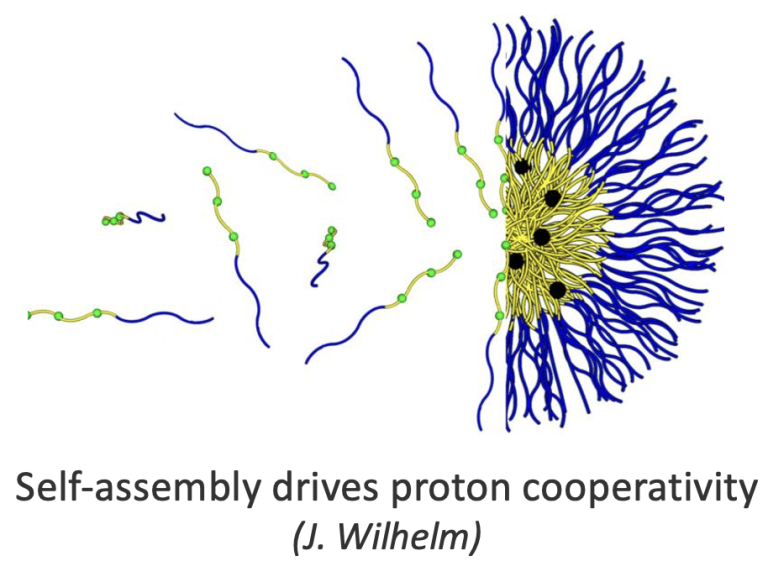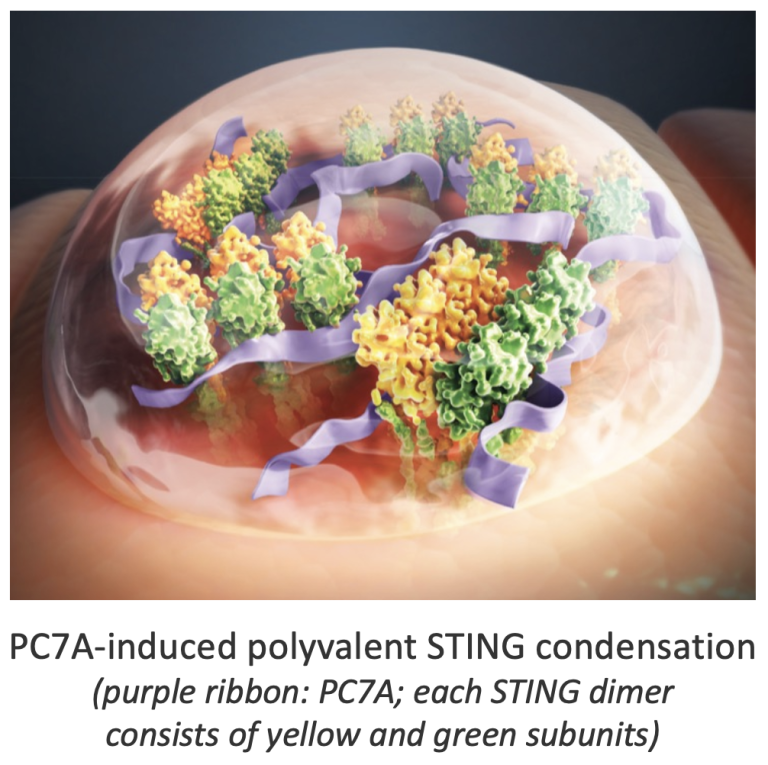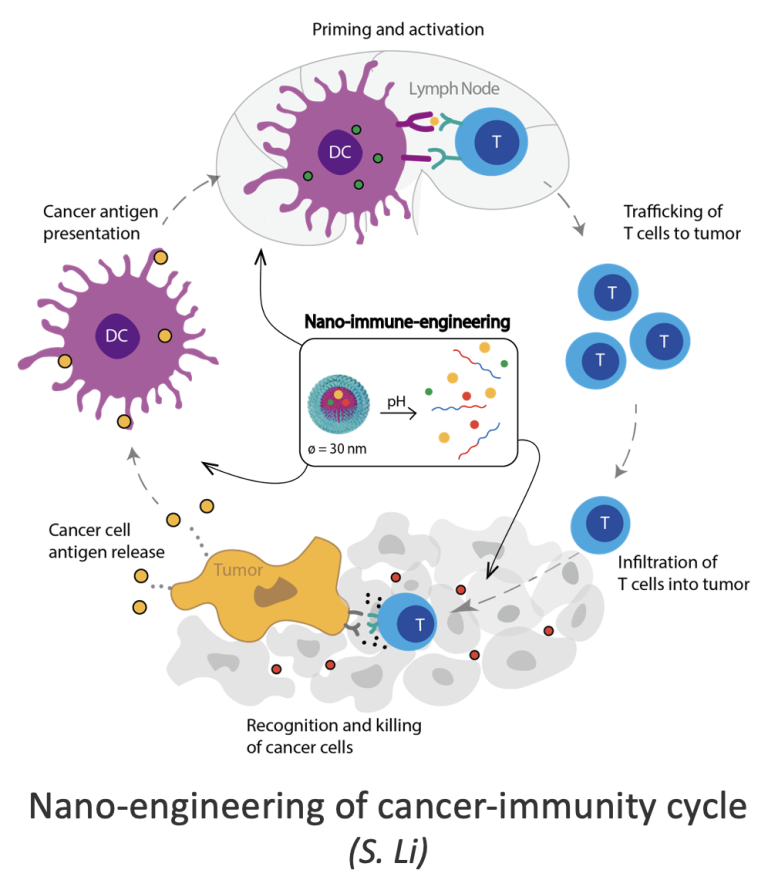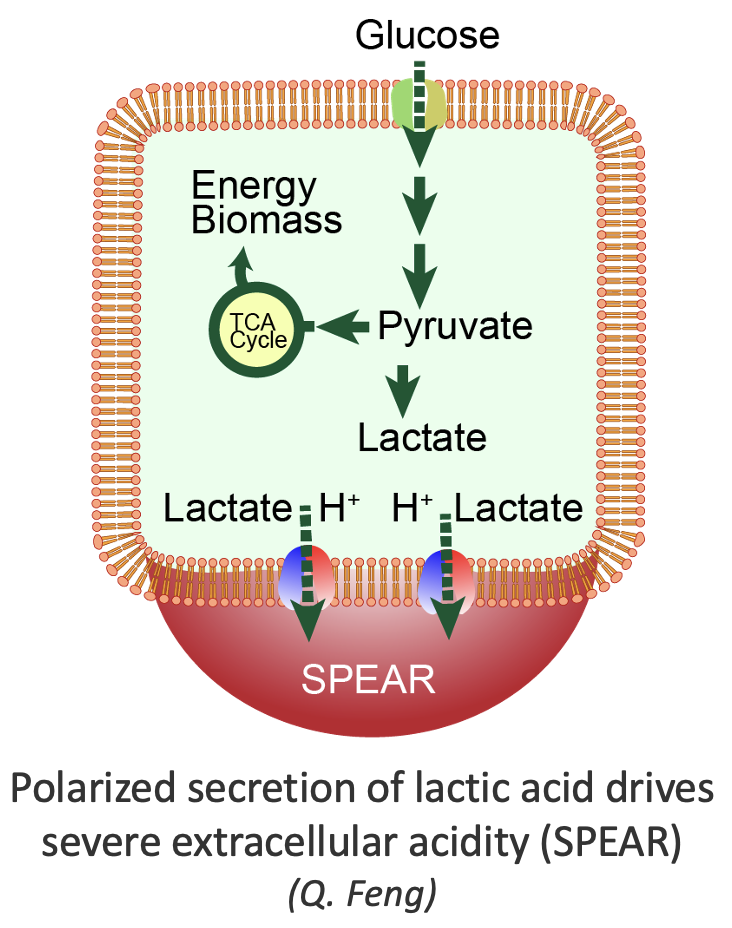Molecular Cooperativity
Cooperativity manifests broadly from biology to society. In biology, cooperativity exhibits inter-dependent multi-component biological processes where the collective outcome surpasses the sum of individual contributions. In nanotechnology, molecular self-assembly offers a versatile and modular strategy to generate functional architectures. We are learning from cues in nature to create dynamic, cooperative nanoparticles that respond to environmental stimuli. Recently, our lab has discovered several unique cooperative systems with all-or-nothing bistable states without intermediates. In a notable example, hydrophobic micellization drove divergent proton distribution of ultra-pH sensitive nanoparticles (dubbed proton transistors) with a Hill coefficient of 51, by far the largest reported in the scientific literature. On-going research focus on deciphering the molecular principles of cooperative systems and applying these insights as a key design concept to innovate nanotherapeutics to improve the precision of medicine.
Selected Publications:
- Ma X, Wang YG, Zhao T, Li Y, Su LC, Wang Z, Huang G, Sumer BD, Gao J. Ultra-pH Sensitive Nanoprobe Library with Broad pH Tunability and Fluorescence Response. J. Am. Chem. Soc. 2014, 136, 11085-11092. PDF
- Li Y, Zhao T, Wang C, Lin Z, Huang G, Sumer BD, Gao J. Molecular basis of cooperativity in pH-triggered supramolecular self-assembly. Nature Comm. 2016, 7, 13214. PDF
- Li Y, Wang Y, Huang G, Gao J. Cooperativity Principles in Self-Assembled Nanomedicine. Chem. Rev. 2018, 118, 5359-91. PDF
- Wilhelm J, Wang Z, Sumer BD, Gao J. Exploiting nanoscale cooperativity for precision medicine. Adv. Drug Deliv. Rev. 2020, 158, 63-72. PDF
- Wang M, Singh P, Feng Q, Wilhelm J, Bennett ZT, Huang G, Gao J. Elucidation of Protonation Cooperativity of STING-Activating Polymer. Adv. Mater. 2023, 2305255.

STING Immunity
The stimulator of interferon genes (STING) pathway for cytosolic DNA sensing plays a critical role in immune defense against cancer. Although small molecule STING agonists have shown potent antitumor activities in mouse models, they have not yet demonstrated significant efficacy in patients. Our lab is deeply engaged in the immune engineering of the molecular and cellular underpinnings of the STING pathway. Recently, we discovered a unique class of synthetic polymers that allow non-canonical STING activation via cooperative, polyvalent STING condensation. Polymer-mediated STING activation prevents rapid lysosomal degradation, thereby prolonging type I-interferon expressions over small molecule agonists. These nanoparticles exhibited robust adjuvancy and cytotoxic T cell response in vaccine use. Using a 'shock-and-lock' STING-activating nanoparticle, we elucidate the crucial role of conventional type 1 dendritic cells (cDC1) in STING-mediated tumor rejection. A related nanoparticle agonist is under evaluation in cancer patients with advanced solid tumors (NCT06022029). Current research focus on evaluating STING-cDC1 biology in patient-derived tumoroids and its ability to overcome tumor immune resistance to checkpoint blockade therapy.
Selected publications:
- Bennett ZT, Li S, Sumer BD, Gao J. Polyvalent design in the cGAS-STING pathway. Seminars in Immunology. 2021, 101580, 1044-5323. PDF
- Luo M, Wang H, Wang Z, Cai H, Lu Z, Li Y, Du M, Huang G, Wang C, Chen X, Porembka MR, Lea J, Frankel AE, Fu Y, Chen ZJ, Gao J. A STING-activating nanovaccine for cancer immunotherapy, Nature Nanotech. 2017, 52. PDF
- Li S, Luo M, Wang Z, Feng Q, Wilhelm J, Wang X, Li W, Wang J, Choka A, Fu Y, Sumer BD, Yu H, Gao J. Prolonged activation of innate immune pathways by a polyvalent STING agonist. Nature Biomed. Eng. 2021, 5, 455-466. PDF
- Wang J, Li S, Wang M, Wang X, Chen S, Sun Z, Ren X, Huang G, Sumer BD, Yan N, Fu YX, Gao J. STING licensing of type I dendritic cells potentiates antitumor immunity. Sci. Immunol. Accepted.

Nano-Immuno-Oncology
Nano-immuno-oncology is an emerging cross field that harnesses nanotechnology’s unique synergy with immunology to advance cancer immunotherapy. Human immune system has evolved to sense and respond to nano- and micro-particulates such as virus and bacteria. Through the versatile control of composition, size, shape, and surface properties of nanoparticles, nanotechnology approaches are uniquely positioned to mount appropriate immune responses against cancer. Our lab is leveraging the all-or-nothing protonation cooperativity of the ultra-pH sensitive nanoparticles and non-canonical STING activation to augment the cancer-immunity cycle toward anti-tumor immunity. These efforts include T cell vaccination by coordinating cytosolic delivery of tumor antigens to dendritic cells with simultaneous activation of STING, tumor-targeted delivery of acidotic inhibitors to overcome T cell retardation, and pH-activatable delivery of immune cytokines. Through an NCI-sponsored U54 Nano-Immune-Engineering Center Award, we are integrating nanotechnology, immune cell biology and tumor immunology to advance cancer immunotherapy.
Selected publications:
- Luo M, Liu Z, Zhang X, Han C, Samandi L, Dong C, Sumer BD, Lea J, Fu Y, Gao J. Synergistic STING activation by PC7A nanovaccine and ionizing radiation improves cancer immunotherapy. J. Controlled Release. 2019, 300, 154-160. PDF
- Huang T, Feng Q, Wang Z, Li W, Sun Z, Wilhelm J, Huang G, Vo T, Sumer BD, Gao J. Tumor-Targeted Inhibition of Monocarboxylate Transporter 1 Improves T-Cell Immunotherapy of Solid Tumors. Adv. Healthcare Mater., 2020, 2000549. PDF
- Wilhelm J, Perez MQ, Basava V, Gao J. Antigen Folding Improves Loading Efficiency and Antitumor Efficacy of PC7A Nanoparticle Vaccine. J. Controlled Release. 2020, 329, 353-360. PDF
- Wang X, Wilhelm, J, Li W, Li S, Wang Z, Huang G, Wang J, Tang H, Khorsandi S, Sun Z, Evers B, Gao J. Polycarbonate-based Ultra-pH Sensitive Nanoparticles Improve Therapeutic Window. Nature Comm.2020, 11, 5828. PDF
- Li S, Bennett ZT, Sumer BD, Gao J. Nano-Immune-Engineering Approaches to Advance Cancer Immunotherapy: Lessons from Ultra-pH-Sensitive Nanoparticles. Acc. Chem. Res. 2020, 53, 11, 2546-2557. PDF

Acidotic Metabolism
Emerging evidence underscores the complex immune cell-metabolite interplay within the tumor microenvironment. Aerobic glycolysis (aka Warburg effect) produces a large amount of lactic acid to satisfy the bioenergetic needs of cancer cells. Our recent findings reveal a unique ‘Dr. Jekyll and Mr. Hyde’ paradox in the immune metabolism landscape: although lactic acid is known to be toxic to immune cells, lactate, counterion of lactic acid and byproduct of strenuous exercise, is surprisingly immune protective of cytotoxic T cells against malignancy. Using multi-chromatic pH nanosensors, we further revealed a severely polarized extracellular acidic region (SPEAR) below pH 5.4 from cancer cells, depicting protons from lactic acid as the cause for immune suppression. The severe pH is validated in patient tumors by pegsitacianine (pKa = 5.3). Current research is focusing on dissecting the biochemical mechanism of SPEAR formation, and developing new diagnostic and therapeutic strategies against severe tumor acidity to overcome immune suppression.
Selected publications:
- Feng Q, Liu ZD, Yu XX, Huang TY, Chen JH, Wang J, Wilhelm J, Li SX, Song JW, Li W, Sun ZC, Sumer BD, Li B, Fu YX, Gao J. Lactate Increases Stemness of CD8+ T Cells to Augment Anti-Tumor Immunity. Nature Comm. 2022, 13, 4981. PDF
- Feng Q, Bennett Z, Grichuk A, Pantoja R, Huang TY, Faubert B, Huang G, Chen MY, DeBerardinis RJ, Sumer BD, Gao J. Polarized, Severe Acidity of Cancer Cells as a New Target for Cancer Diagnosis and Therapy. Nature Biomed. Eng. Accepted.
- Huang G, Zhao T, Wang C, Nham K, Xiong Y, Gao X, Wang Y, Hao G, Ge WP, Sun XK, Sumer BD, Gao J. PET Imaging of Occult Tumours by Temporal Integration of Tumour-Acidosis Signals. Nature Biomed. Eng. 2020, 4, 314. PDF

Tumor Imaging & Surgery
Over 1 million cancer surgeries are performed in the US and 5 millions worldwide each year. Obtaining tumor-free surgical margins is important to achieve disease-free survival, while minimizing the removal of normal tissues is equally important to preserve the quality of life. To achieve clear tumor detection from diverse tissue origin and cancer types, we have developed a transistor-like pH threshold sensor to image tumor acidosis, a cancer hallmark from aerobic glycolysis of cancer cells. HomoFRET-induced fluorescence quenching was employed at the micelle state to abolish fluorescent signals during blood circulation, but allow exponential activation in the acidic tumor microenvironment. The signal amplification strategy allowed the detection of occult tumor nodules <1 mm in size. Real-time, fluorescence-guided surgery achieved >70% cancer cures in mice bearing head and neck tumors. The recently completed Phase 1 and 2 clinical trials demonstrate the safety and effectiveness of pegsitacianine (ONM-100) in tumor detection, which led to the Breakthrough Therapy Designation by the FDA.
Selected publications:
- Wang Y, Zhou K, Huang G, Hensley C, Huang X, Ma X, Zhao T, Sumer BD, DeBerardinis RJ, Gao J. A Nanoparticle-based Strategy for the Imaging of a Broad Range of Tumours by Nonlinear Amplification of Microenvironment Signals. Nat. Mater. 2014, 13, 204-212. PDF
- Zhao T, Huang G,Yang S, Ramezani, S, Li Y, Wang Y, Ma X, Xie XJ, Thibodeaux J, Sun X, Sumer BD, Gao J. A Transistor-like pH Nanoprobe for Tumour Detection and Image-Guided Surgery. Nature Biomed. Eng. 2016, 1, 0006. (Featured by Science daily news, Dallas Morning News, NBC5, and CBS11) PDF
- Bennett ZT, Feng Q, Bishop JA, Huang G, Sumer BD, Gao J. Detection of Lymph Node Metastases by Ultra-pH-Sensitive Polymeric Nanoparticles. Theranostics. 2020, 10(7), 3340-3350. PDF
- Voskuil FJ, Steinkamp PJ, Zhao T, van der Begt B, Koller M, Doff JJ, Jayalakshmi Y, Hartung JP, Gao J, Sumer BD, Witjes MJH, van Dam GM. Exploiting metabolic acidosis in solid cancers using a tumor-agnostic pH-activatable nanoprobe for fluorescence-guided surgery. Nature Comm. 2020, 11, 3257. PDF
